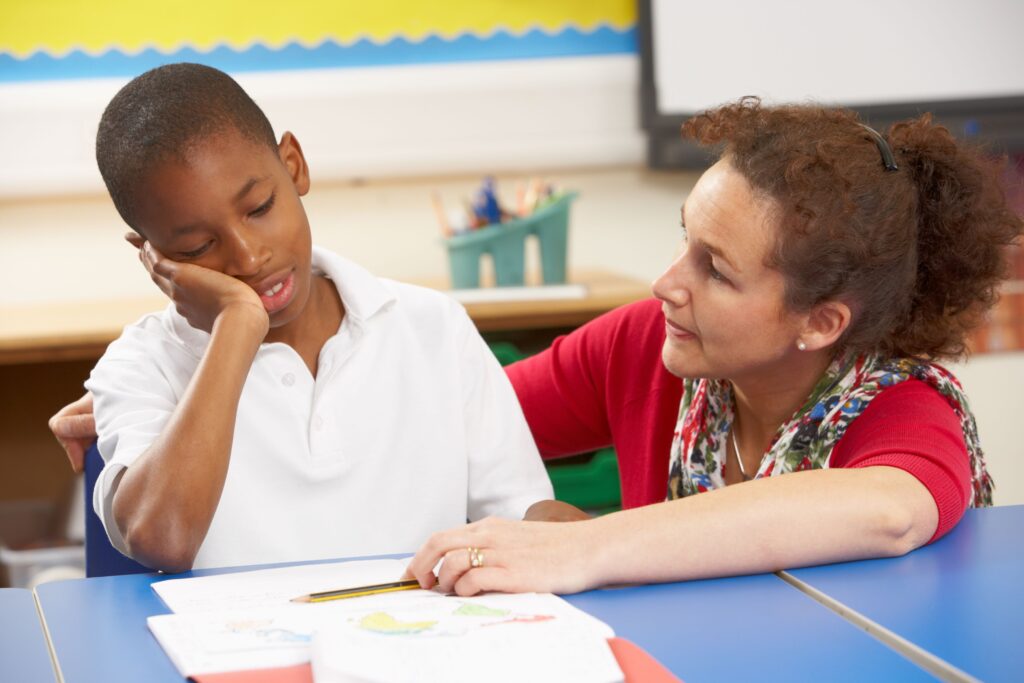Our teaching world changed drastically during the COVID-19 pandemic. Teachers had to change the way they taught and the way they implemented behavior management strategies.
The initial pandemic is over, but we are left with students who experienced trauma for the two years it affected the world. Trauma-sensitive classroom management is essential.
Much of it is still seen in the classrooms of today. Students are not coping well with change, have trouble sustaining relationships with peers, using conflict management, and have experienced a sense of isolation that lingers.
They may have difficulty in self-regulation, appear anxious, think negatively, and have trust issues. Teachers are expected to employ trauma and resilience strategies within classrooms.
What Does Trauma-Sensitive Classroom Management Look Like?
Consistency
Consistency, predictability, and structure are important when it comes to trauma-sensitive classroom management.
Teachers should use methods like posting schedules, and explicitly reviewing expected behaviors before each activity and transitions so students are not guessing and wondering what is going to happen next. They need to know the expectations and how to achieve them. This promotes a sense of security.
Good Student-Teacher Relationships
Building good relationships with students goes a long way. Give a survey at the start of the year, either verbally for younger students or on paper for older students.
Find out about family, personal interests, and hobbies. Use this information to make connections in a more personal way.
Consider spending some one-on-one time with kids, at lunch or during a free time spot in the day. Share personal stories with them and let them share with you.
Consider attending an event of theirs. Students who develop trusting relationships with their teacher are less likely to misbehave and more likely to confide in you when something is wrong.
It is vital to expect out-of-the-ordinary responses from students and have strategies to employ.
We never know what triggers students or even if they are coming in triggered by something that happened at home. It is good to have students identify the feelings they are coming to school with and determine if they need to do anything to get to the point at which they can learn.
At the early grades, it may be having the entire class discuss or point to a picture indicating their feelings. At upper grades, this may be kids checking in on an iPad or paper.
Start the Day Positively
Teachers can see how kids feel and use methods to start the day positively. If students indicate they are coming in heightened, they can use a calming corner. A calming corner is a safe spot in the classroom where students can go to any time to use items to help them relax, switch what they are thinking about, and get to a better place mentally.
Different items allow them to express themselves quietly or get the fidgets out so they can rejoin the class and learn. Some students need to move to regulate. They can give a signal to the teacher that they need a walk or movement activity. Teachers can call a pre-arranged partner to watch the child as they take their walk/break.
It is important students be checked regularly and interacted with to change focus so that they are not ruminating on their worry alone and making the problem worse. Schools should be safe places for students. Teachers can explicitly teach that regularly.
Communications should be thoughtful, deliberate, and proactive when working with students. Students of trauma do not do well with power struggles or commands without rationale. It is best to give reasons for directives, such as: “please pick up the supplies from around your desk area so that other students do not break them or fall down.”
Teachers can use silent signals with students as a part of trauma-sensitive classroom management. If the teacher works with students early on and they come to an agreement that she will put a hand on their shoulder when they need to stop doing something, it is easy to walk over and do that without getting into verbal discussions over the direction. Students will not be embarrassed and will stay in a safe space with the teacher.
Student Choice
The trusting relationship must be the precursor to ongoing interactions. Student choice is key. If the teacher wants the student to be in a less crowded environment, for example, offer a choice, “Do you want to be in this group or that group of desks?”
The groups would be on the periphery of the class so that either choice would allow the child to be in a less crowded environment. A teacher using effective, proactive communication can greatly reduce the amount of redirection needed and help students to be more successful.
Highlight Student Strengths
Highlighting strengths of students can improve their attitude toward school and make them feel less inadequate. It can build the sense of competence and help them to feel positively about themselves.
Asking students to peer tutor or go into a younger grade to assist can give a student a sense of accomplishment.
Through trauma-sensitive classroom management, teachers may also give these students a special job. Taking lunch count, helping with certain technology items, or being an “assistant” in another class can go a long way to helping the feelings of competence that students need to have.
The teacher can speak positively about the future and compliment students on what they are doing well. Highlighting that a certain skill will make them successful in a certain career can give the student positive thoughts about their future and the ability to achieve something.
The Importance of Classroom Management Post-COVID
Students returned to the classrooms after COVID-19 pandemic struggling not just academically, but less motivated, more emotional, and more defiant.
Kids were not used to everyday conflict management with peers. For these reasons, the key to getting students to gain academic achievement is so dependent upon classroom management.
Without strong classroom management in a way that is not threatening to students coping with trauma, these academic gains will not be realized.
Educators never stop learning; check out our available graduate degree programs to hone your skills and promote lifelong learning and academic excellence.




